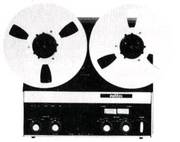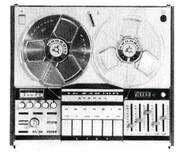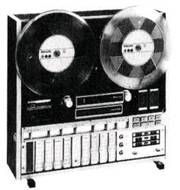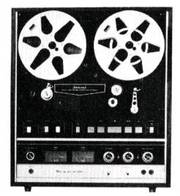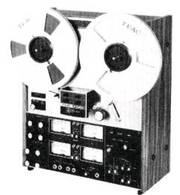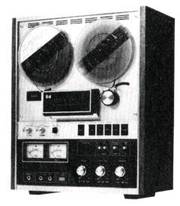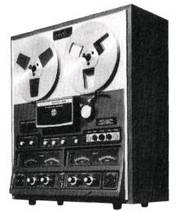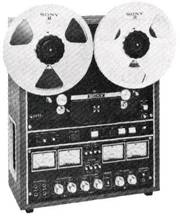"off duty" 1970 - 1997 - eine Freizeit-Zeitung für's US-Militär
Die in diesem amerikanischen (Freizeit-) Shopping-Magazin angepriesenen Hifi- und Video-Produkte waren auschließlich amerikanischen und kanadischen Militärangehörigen zugänglich - also zu kaufen - und vor allem zu ganz ungewöhnlich (verblüffend) niedrigen US $ Military-Preisen. Zu der einführenden "off duty" Seite geht es hier lang. - Um 1970 begann der weltweite Hifi-Boom bis zum 1. Crash 1978 und dann wieder zum 2.Crash um 1990. Über die 20 Jahre nach 2001 lesen Sie mehr in den Kolumnen auf diesen japanischen Seiten.
.
Hier im Juni 1972 werden die letzten neuen Typen vorgestellt.
Inzwischen hatte die Japaner den Markt der Home-Consumer Tonbandgeräte fast völlig übernommen, jedoch an die Revox A77 aller Varianten kamen sie nicht ran. Diese Bandmaschine entwicklete sich zum Synonym für "open reel"- Magnetbandgeräte.
.
What's New In Open Reel (in June 1972)
By WALTER B. RIOS
WHITHER THE Tape Recorder, in the face of competition from cartridge and cassette?
(Wohin geht der Weg der Bandmaschinen im Angesicht der Cartidges und der Kassetten ?)
A look at some new models, released since our Shopper survey last September, clears up the question of the direction open-reel tape is heading.
Three-motor design, with a separate take-up motor for each reel, is already commonplace, except where the designer deliberately eschews it to save space and weight.
A 3-head configuration, employing separate heads for recording and playback to permit off-the-tape monitoring, is also old-hat by now.
Increasingly common, too, is the convenience of electrical controls, employing pushbutton solenoids instead of levers to control tape motion. National Panasonic's latest top-of-the-line model, the RS-715 US, is the first deck from that company to feature solenoid controls, and Akai also offers them in its top-price models, such as the 280D-SS 4-channel deck.
Not so common is a circuit called "logic" or "memory." It's a sensing circuit that prevents tape from spilling or breaking from careless handling of the controls.
The machine won't go into "play" mode until all tape motion has stopped. This can be particularly important with jumbo 10 1/2-inch reels, which don't stop instantly at the touch of a button, as a rule, because of their weight.
Throw the mechanism into play before they grind to a complete halt and you invite trouble. The logic circuit "reads" your command but doesn't act on it until motion stops and it's safe to go ahead.
This is featured on Sony's top-priced models, on an elaborate machine from Philips (the N4450) and on the Sansui SD5000.
.
A circuitry innovation that's taken even longer to trickle down from recording-studio heights to the domain of audiophiles is the pro console's provision for synchronization. The need for it in the studio is obvious. With 16-channels (or 20, or 24 yet) recorded on 2" tape, bits of the orchestra are frequently recorded separately, or a singer can do his thing in the privacy of a separate studio, his back-up sound piped in via headphones.
If there's a blooper somewhere, the faulty track can be remade without the expense of reassembling the entire group. With separate recording and playback heads, synchronization would be all but impossible, however.
The pros get around this by provisionally switching into playback mode, so the channels being monitored are in perfect synch with the channels being recorded.
We first spotted the provision for synch on a special 4-channel version of Sony's TC-850, unveiled at last fall's convention of the Audio Engineering Society (AES) in New York.
Known as the TC-854-4S, it's the subject of a test report in the May issue of "High Fidelity" and sells Stateside for a cool $1,695. At a lower price, look for synch on a new jumbo Teac, model A-3340, introduced in March at the Sonex show in London and due shortly at audio clubs in Europe.
The serious amateur or semipro recordist, like his well-heeled counterpart in the professional studio, is concerned with noise reduction. And here the magic word is Dolby.
The studio employs a costly system known as the Dolby "A" circuit, which operates in several frequency ranges. At the consumer-product level, Dolby's simpler "B" circuit has been widely adopted, especially in cassette equipment because of the latter's inherently high noise level.
Open-reel models with built-in Dolby circuitry are still rare because the feature is upwards of $100 to the price of the machine.
That hasn't deterred Revox, however, and the highly regarded A77 is now available with twin Dolby circuits (for recording and playback, with full monitoring capability) built in.
A number of single-ended noise reduction systems - which work only in playback - are also in use. They remove noise, too, but cut some of the sparkle from the music.
Most owners of high-grade tape equipment make do without them since they already get superior recordings thanks to the latest in low-noise tapes and newly designed heads.
Akai's glass head and National-Panasonic's hot-pressed ferrite are but two examples - the fact is that all the major manufacturers are continually upgrading the heads and electronics in their late-model machines. The signal-to-noise ratio of 60 dB claimed by Sansui for the SD5000 is a new high - without noise-reduction circuitry.
"shopper survey"
.
.
- Revox A77/Mark III
is the first semipro tape deck with built-in Dolby "B-type" circuitry. The noise-reduction system operates in both recording and playback, boosting high frequencies of low amplitude so that, in playback, a mirror-image cut of the same signals will suppress tape hiss. The Revox employs four complete Dolby modules, two each for recording and playback, permitting full monitoring of both channels. - Grundig's TK-248 U HiFi
uses slide-type level controls reminiscent of a studio console. A "Synch-Play" button permits synchronized sound-with-sound recording in stereo, and a "Multiplay" switch is provided for transferring signals from one track to another. The machine features automatic recording level control which can be switched out if desired. - Philips N-4450
is the company's first bidirectional machine, with six heads for full recording and monitoring capability in each direction. The new 3-motor design takes 10/2-inch reels and has all-solenoid controls with motion-sensing "memory" circuitry to prevent tape spillage. A built-in clock/timer device permits the machine to be preset to start and stop at desired times, up to 24 hours in advance. A monitor amplifier (50 watts IHF music power) is also built in. - Sansui SD-5000
boasts a 60 dB signal-to-noise ratio without noise-reduction circuitry. Solenoid controls of this 3-motor machine feature electronic delay circuit to prevent tape spillage, even if deck is thrown into "play" mode directly from "fast forward" without breaking the moving reels. Four heads are provided, including two separate playback heads for bidirectional operation. - Teac A-3340
is a new 4-channel tape deck with synchronization of each channel, by means of a "Simul-Synch" switch provided for each of the recording head's four gaps. The 2-speed machine (15 and IV2 ips) has three motors, solenoid controls, three 4-channel heads and line/ microphone mixing on all four channels. It accepts IO/2-inch NAB tape reels. - National-Panasonic RS-715US
is an automatic-reverse tape deck that will play continuously in both directions if desired, employing separate playback heads in each direction. Recording and playback heads are all of the new hot-pressed-ferrite (HPF) type. The 3-motor tape transport is the first from Panasonic with pushbutton solenoid controls. - Akai 280D-SS
is the most elaborate 4-channel machine introduced thus far by Akai, has 3-motor mechanism and all-solenoid controls permitting remote control operation with an optional accessory. The capstan-drive motor features a speed-detecting cog-wheel for servo control to stabilize tape travel. Four heads include separate 4-gap heads for recording and playback plus full-track and half-track erase heads for 2- or 4-channel operation. - Sony TC-854-4S
is a new 4-channel version of model TC-850 already available in audio clubs, featuring closed-loop dual capstan tape drive with three motors, IO/2-inch reel capability and variable speed control. An automatic program scanner circuit cues the tape automatically to the starting point indicated by a strip of metallic foil. New 4-channel model offers "Synchro-Trak" for each of the four gaps on the recording head, switching any desired channels into playback mode in synchronization with channels being recorded.
.


